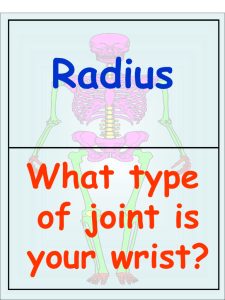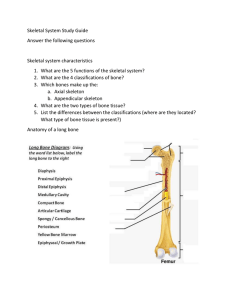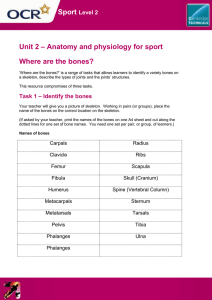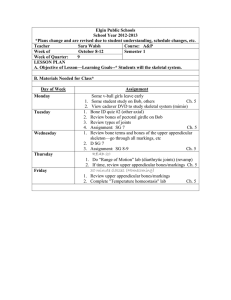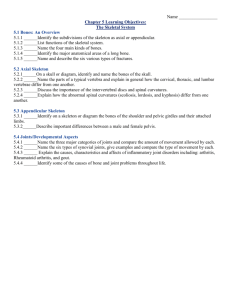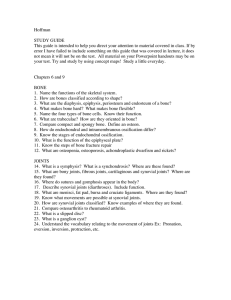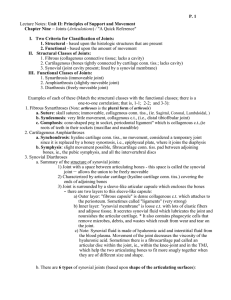Biol 2304/2101 Human Anatomy 5 points each
advertisement
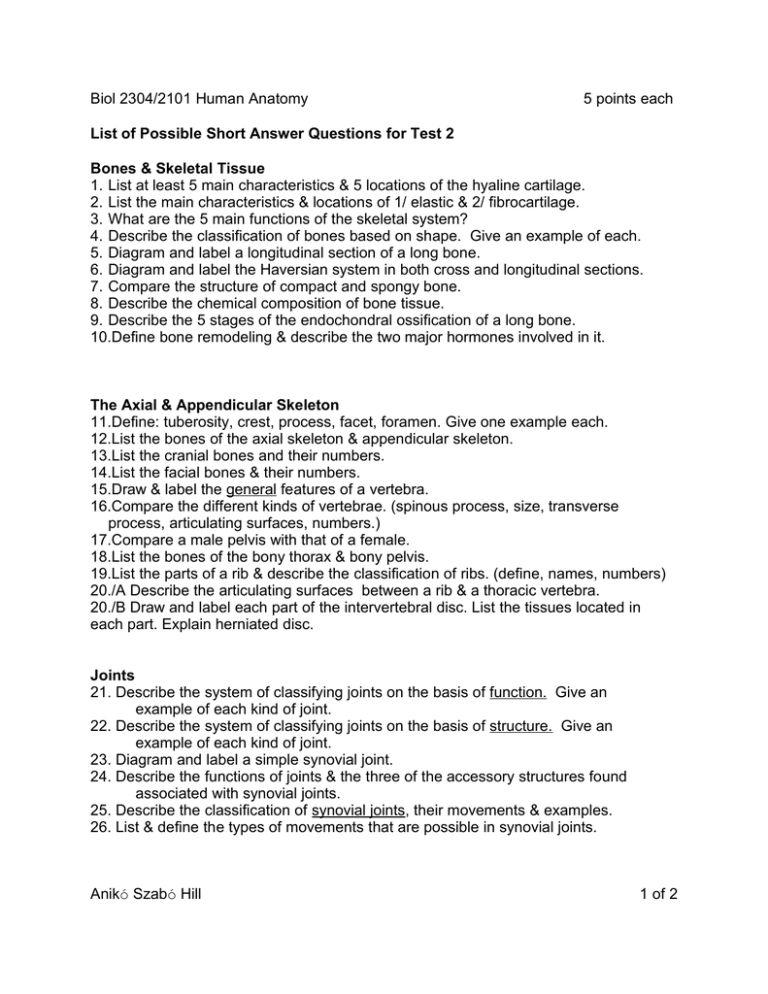
Biol 2304/2101 Human Anatomy 5 points each List of Possible Short Answer Questions for Test 2 Bones & Skeletal Tissue 1. List at least 5 main characteristics & 5 locations of the hyaline cartilage. 2. List the main characteristics & locations of 1/ elastic & 2/ fibrocartilage. 3. What are the 5 main functions of the skeletal system? 4. Describe the classification of bones based on shape. Give an example of each. 5. Diagram and label a longitudinal section of a long bone. 6. Diagram and label the Haversian system in both cross and longitudinal sections. 7. Compare the structure of compact and spongy bone. 8. Describe the chemical composition of bone tissue. 9. Describe the 5 stages of the endochondral ossification of a long bone. 10.Define bone remodeling & describe the two major hormones involved in it. The Axial & Appendicular Skeleton 11.Define: tuberosity, crest, process, facet, foramen. Give one example each. 12.List the bones of the axial skeleton & appendicular skeleton. 13.List the cranial bones and their numbers. 14.List the facial bones & their numbers. 15.Draw & label the general features of a vertebra. 16.Compare the different kinds of vertebrae. (spinous process, size, transverse process, articulating surfaces, numbers.) 17.Compare a male pelvis with that of a female. 18.List the bones of the bony thorax & bony pelvis. 19.List the parts of a rib & describe the classification of ribs. (define, names, numbers) 20./A Describe the articulating surfaces between a rib & a thoracic vertebra. 20./B Draw and label each part of the intervertebral disc. List the tissues located in each part. Explain herniated disc. Joints 21. Describe the system of classifying joints on the basis of function. Give an example of each kind of joint. 22. Describe the system of classifying joints on the basis of structure. Give an example of each kind of joint. 23. Diagram and label a simple synovial joint. 24. Describe the functions of joints & the three of the accessory structures found associated with synovial joints. 25. Describe the classification of synovial joints, their movements & examples. 26. List & define the types of movements that are possible in synovial joints. Anikó Szabó Hill 1 of 2 Biol 2304/2101 Human Anatomy 5 points each Muscular System 27.What are the functions of the muscular system? 28. Describe the microscopic characteristics of a skeletal muscle cell/fiber. 29. Describe the macroscopic structure of a muscle organ.(connective tissue coverings) 30. Describe the ultrastructure of a muscle fiber. 31./A Describe the structure of a sarcomere. 31./B Describe the structures of the thin and thick myofilaments. 32. Be able to briefly describe the sliding filament theory of muscle contraction. 33./A Be able to (1) describe and (2) draw and label a neuromuscular junction. 33./B Be able to (1) describe and (2) draw and label a varicosity. 34.Describe the different criteria for naming muscles, giving an example for each. 35.Give the definition of each arrangements of fascicles & give an example. Clinical questions for extra credit 36. Describe the 3 joint injuries (sprain, dislocation, torn cartilage) & housemaid's knee and student's elbow. 37. Describe 5 different kinds of bone fractures. 38. Describe the normal spinal curvature and the three abnormal types of spinal curvature. 39.Define osteoporosis, osteomalacia, rickets, Paget's disease & ostealgia. 40.Define achondroplasia, gout, lyme disease, bursitis & rheumatoid arthritis. 41.Define Duchenne muscular dystrophy, myopathy, myalgia, spasm & fibromyalgia. Anikó Szabó Hill 1 of 2

